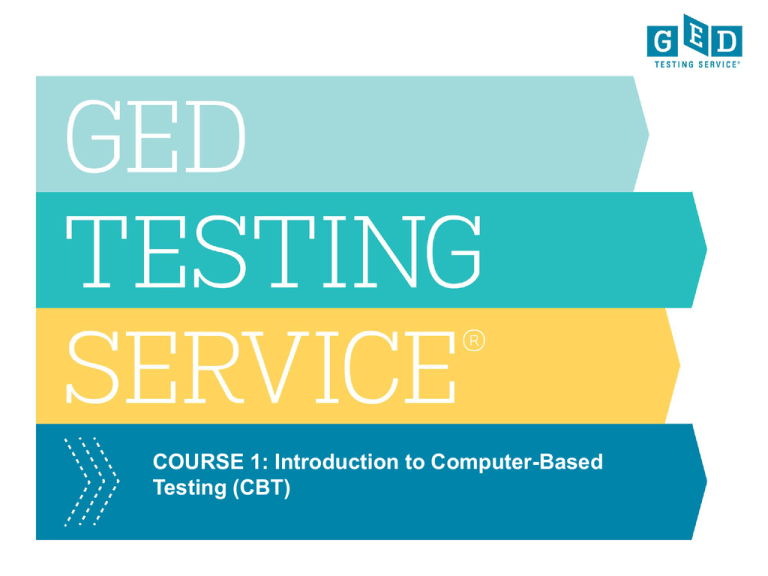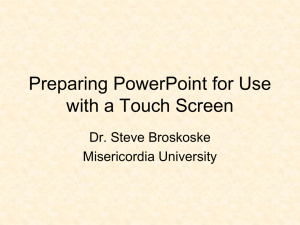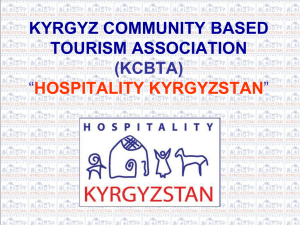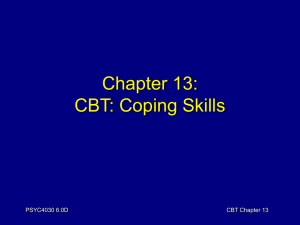COURSE 1: Introduction to Computer
advertisement

COURSE 1: Introduction to Computer-Based Testing (CBT) Course 1: Introduction to Computer-Based Testing (CBT) Major Topics • • • • • Introduction to computer-based testing (CBT) CBT and the GED testing program Research-based approach to CBT Our partner Pearson VUE Preparing for CBT implementation 2 Computer-Based Testing (CBT) 3 What is Computer-Based Testing? • Test administration via computer (NOT online) • Responses are recorded and scored electronically • Demographic data collection and reporting completed prior to testing • Advanced questions types available: multiple choice, fill-in-the-blanks, essay, etc. Benefits of Computer-Based Testing • • • • • • • Rapid turnaround on test results Greater choice of where and when to test Centralized registration and scheduling Reduced manual processes and errors Increased test security More standardized, automated processes Quicker updates to test content Who uses CBT today? GED Computer-Based Testing is Not Online • GED testing today is conducted only in official testing centers • GED testing tomorrow will continue to be conducted only in official testing centers You cannot take the GED test online. CBT and the GED Testing Program 8 The GED Reality: 2010’s BIG Gap 39 million U.S. adults without a high school credential 10.5 Million are age 18-34 1.3 million U.S. high school dropouts annually ~ 800,000 GED® Candidates ~ 500,000 credentials 9 Today’s Challenges • Labor-intensive • Multiple approaches--to achieve economies of scale • Limited access • Time to process credential • Lack of flexibility 10 CBT and the GED Testing Program • Will use the 2002 Series GED Test until 2014 • Will continue to have 5 parts, calculator and scrap materials available for work and notes • Testing centers will need to be approved by Pearson VUE for computer-based GED test delivery • All jurisdictions should begin CBT implementation by the end of 2013 Our Partner Pearson VUE 12 Our Partner: Pearson VUE • Leader in global CBT administration • 600 academic testing sites in the U.S. alone • Facilities support enhanced testing security • More than 275 Pearson VUE® Authorized Test Centers on military bases • Dedicated to education and lifelong learning Research-Based Approach 14 CBT Pilot Research 1: Usability Study • Goals: To understand how test-takers would interact with the GED® test; To make improvements where necessary • Methods: Study tested and reviewed user ability with: • • • • • • Mouse Keyboard Scroll bar Understand and use exhibit windows Provide (and change) a response Navigate through set-based questions CBT Pilot Research 2: Comparability Study • Goal: Ensure scores on the GED® tests delivered through paper-based testing (PBT) and computer-based testing (CBT) are comparable • Methods: – Eleven jurisdictions – Eligible participants granted a “practice opportunity” – Same test forms administered in PBT/CBT – Matched sample of CBT participants’ scores with PBT candidates Is the GED Testing Field Ready for CBT? About the same percentage (60%) offer computerbased testing (outside of GED tests) Almost 60% of test centers already have computers—23 computers on average 9 states have computers available in at least 75% of their current test centers: Yes, but we still have work to do… California, Michigan, and Texas each had more than 50 centers with potentially available additional computers 17 Preparing for CBT Implementation 18 Preparing for Computer-Based Testing Implementation • • • • Policies: Testing, as well as local and state Data: Management and storage Capacity: Site selection Communications: Marketing resources, preparing jurisdictional staff, gaining popular and legislative support • Support from GED Testing Service: Field Outreach, Marketing and CBT Implementation teams 19 Planning CBT Implementation • Discovery Process – Jurisdictional implementation team consults with GED Testing Service • What are the main components of the plan? • Who needs to be involved in its development? • What is the time commitment to develop the plan? • Strategic Implementation Plan – Second consultation with GEDTS to review discovery and to develop plan • CBT Implementation – Approve and begin implementation plan 20 Conclusion Thank you for your interest and participation! Next Steps • You Should Review: – Supplement 1A: Benefits of Partnership – Supplement 1B: Usability Study Overview – Supplement 1C: Comparability Study Overview • You Can Share: – This presentation and related materials are available on www.GEDcbt.org and on GED AccessPoint 21 To learn more about computer-based testing and the GED testing program, review these other courses online at www.GEDcbt.org: • • • • • • • • Course 2: Becoming a Pearson VUE Test Center (PVTC) Course 3: CBT Pricing Course 4: CBT Policies in the GED Testing Program Course 5: Registration and Scheduling Course 6: CBT in Correctional Facilities Course 7: Channel Management Course 8: CBT Implementation Readiness & Checklist Course 9: CBT Communications 22







